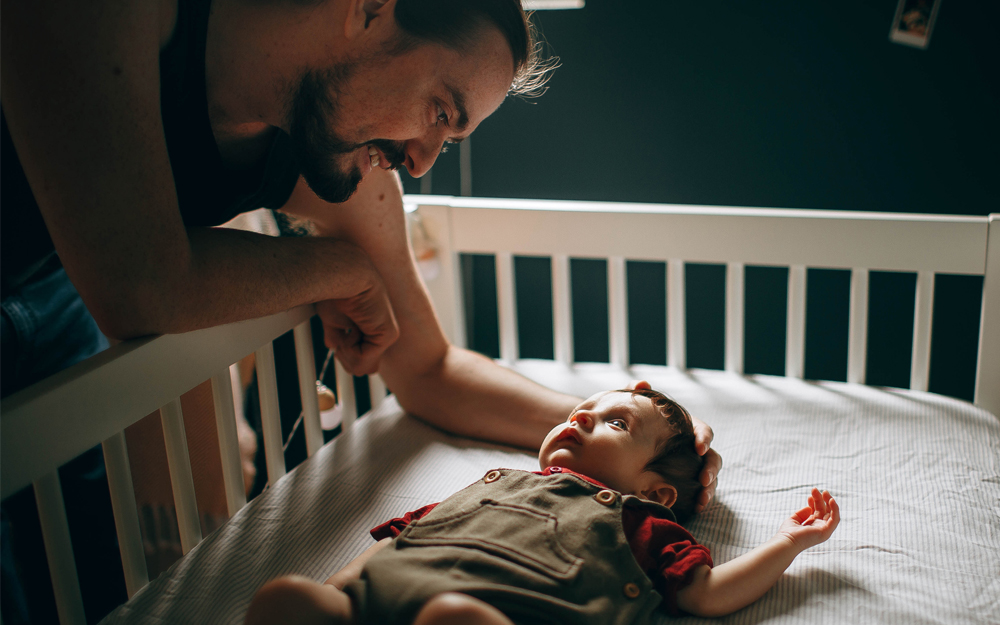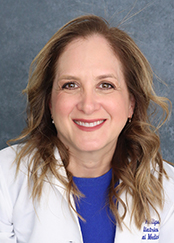Cedars-Sinai Blog
Tips for Safer Sleep for Babies
Apr 11, 2022 Nicole Levine

Parents with newborns have all been there: The little one is finally asleep, which means they can rest, too—but then comes the jittery worries, the lean in to listen for the steady sound of their breathing, making sure they're still on their backs.
Parents with newborns have all been there: The little one is finally asleep, which means they can rest, too—but then comes the jittery worries, the lean in to listen for the steady sound of their breathing, making sure they're still on their backs.
Sleep can be tricky business for new parents. Dr. Pamela Phillips, chair of Pediatrics for the Cedars-Sinai Medical Group, offers parents a few tips to help them rest easier knowing they've done everything they can to give their baby a safe night of sleep.
"The most important thing is to ignore what it looks like in all the catalogs."
Their first room is your room
The first place a baby should sleep at home is in the same room as their parents. The American Academy of Pediatrics (AAP) recommends placing the baby's sleep area in the same room as their parents for the first six months, Dr. Phillips says.
According to the AAP, 3,400 babies in the U.S. die suddenly and unexpectedly every year while sleeping, and room-sharing can eliminate this risk by as much as 50%. Those causes of death include sudden infant death syndrome (SIDS), suffocation and other causes.
"Most of the time, these sudden deaths in babies are due to accidental suffocation," Dr. Phillips says.
A bassinette, play yard or portable crib next to the bed are all good options. Sharing a room with the baby also makes nighttime feeding and comforting more convenient.
"It's a little unclear why this lowers the risk, but there are a few things that may factor in," Dr. Phillips says.
"The baby, truthfully, probably doesn't sleep quite as deeply with the noise and smell of their parents there," she says. "There's a level of alertness that is probably a little bit higher."
Never let your baby sleep on soft surfaces, including your bed
The AAP never recommends bed-sharing for any babies. The situation is even more dangerous if the child is younger than four months old, the baby was born prematurely or with a low birth weight, the surface of the bed is soft or has soft bedding such as pillows or blankets.
The same goes for armchairs, couches and nursing pillows. Babies can roll on to their sides or stomachs and turn their heads into the soft fabric, suffocating them. Being propped up on an incline against a pillow or lounger can allow their heads to bow forward, blocking their airways.
Use the right products for babies' beds
Whether it's their bassinette, crib or play yard, the same rules apply.
"The most important thing is to ignore what it looks like in all the catalogs," Dr. Phillips says.
Ditch the bumpers, pillows, blankets and toys. None of them belong in a crib. Only three things belong in a baby's safe sleep space: a firm mattress, a fitted sheet made for that specific mattress and the baby.
Back is best
Always put your baby down to sleep on their backs. While a lot of people feel strongly that their babies sleep better on their tummies, that position is strongly associated with a higher rate of accidental deaths.
Reflux is a common problem in babies, and many parents worry that letting their babies sleep on their backs will lead to choking. It won't, Dr. Phillips says.
"We don't see babies aspirating from reflux," she says. "So, we always tell parents that it's still best to put their babies down to sleep on their backs."
However, once a baby can roll themselves over, they can sleep in other positions. Just make sure there are no soft items in the crib that they could roll onto and block their airflow.
"Your job is to put them on their back in a safe sleep space," Dr. Phillip says. "Once they can roll themselves over and lift their heads, that is their business. You don't have to stay up all night flipping them over."
She usually warns parents at their four-month checkups that their little one might be rolling soon.
"I assure them they don't have to panic, because it can be scary for parents," she says. "I think most parents stare at their babies for the first few nights just to make sure everything is OK."
Be careful about daytime sleep
The same rules for safe nighttime sleep apply for daytime sleep. Rockers, swings and car seats are not safe places for babies to sleep unobserved.
"A lot of these products keep babies in a position where their heads tip down, and it can really obstruct their airway," she says. "Those things are fine when they're awake and you're with them, but they should never be left in them for unobserved sleep."
Set an alarm for yourself during feedings
Falling asleep during a feeding is inevitable for exhausted new parents. Set an alarm on your phone for every 10 minutes when feeding so you can wake up and put the baby back down into their safe sleep space.
It's also a good idea to set up for feeding in a place with limited hazards: Feed in a position with no blankets or pillows around you, so if you do fall asleep, there's less chance of suffocation.
Keep cool
Getting too hot can cause babies to fall into a deeper sleep—and that's not ideal, Dr. Phillips says. Keep the room temperature between 68 and 72 degrees.
"Babies don't really need to be bundled," she says. "We want them in just one more layer over their onesie or pajamas. A wearable blanket is a perfect extra layer."
If a baby is sweating or their neck feels very warm, they're too hot.
Share your sleep concerns with your pediatrician
It's normal to have questions and worries about sleep. Don't hesitate to talk to your pediatrician, Dr. Phillips says.
It's also a good idea to stay on top of routine pediatric appointments to identify and address any medical issues that might arise.
Provide a sleeping space that prioritizes safety, and everyone will rest easier.




